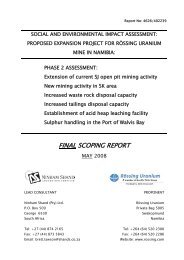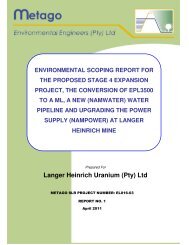Atomic Energy Board of Namibia - The Chamber of Mines Uranium ...
Atomic Energy Board of Namibia - The Chamber of Mines Uranium ...
Atomic Energy Board of Namibia - The Chamber of Mines Uranium ...
Create successful ePaper yourself
Turn your PDF publications into a flip-book with our unique Google optimized e-Paper software.
19. Transitional Matters<br />
While the Hazardous substance ordinance, 1974<br />
(Ordinance No. 14 <strong>of</strong> 1974) provides the current basis <strong>of</strong><br />
permitting certain practices and activities, the Authority<br />
has recognized the need to ensure a smooth transitional<br />
phase after the operationalisation <strong>of</strong> the Act. <strong>The</strong>refore all<br />
attempts are made to model the current regulatory work<br />
around the Act and draft regulations in preparation for<br />
the operationalisation <strong>of</strong> the new legislative framework.<br />
20. Regulatory Approach<br />
<strong>The</strong> new legislative framework has a number <strong>of</strong><br />
requirements with which applicants must comply with,<br />
including those stipulated in the Act and under the draft<br />
regulations. In an effort to streamline the applications<br />
and review process the Authority has issued a guideline<br />
that will assist applicants to compile a Radiation<br />
Management Plan in support <strong>of</strong> an application for a<br />
registration, license or authorization. Applicants are<br />
required to develop and when approved implement<br />
their respective radiation management plan, which is<br />
expected to be in compliance with all requirements<br />
defined in both the Act and the regulations.<br />
21. Register <strong>of</strong> radiation sources<br />
<strong>The</strong> Authority keeps and maintains a database for<br />
radiation sources and facilities, called the Regulatory<br />
Authority Information System (RAIS). While the database<br />
is estimated to be complete there are a few challenges<br />
such as inclusion <strong>of</strong> operators performing mining and<br />
exploration work and there might be some operators<br />
utilizing sealed source in industry without authorization.<br />
All efforts are being made to setup the current database<br />
on the local area network on a trial basis with the<br />
intention to launch a web-based database.<br />
While the Authority is fully equipped and capable to<br />
inspect radiation sources in the medical and industrial<br />
sectors, the challenge remains to build the same<br />
capacity for the uranium mining sector. <strong>The</strong> expertise for<br />
inspection in the uranium mining industry together with<br />
the review <strong>of</strong> the radiation management plans will be<br />
key priorities in the coming years if the mandate <strong>of</strong> the<br />
Authority is to be executed effectively.<br />
23. Extent <strong>of</strong> Radiation Exposure in <strong>Namibia</strong><br />
One <strong>of</strong> the functions <strong>of</strong> the Authority is to inform the <strong>Board</strong><br />
about the extent <strong>of</strong> radiation exposure in <strong>Namibia</strong>. <strong>The</strong><br />
target <strong>of</strong> the assessment <strong>of</strong> radiation exposure includes<br />
exposures to the radiation workers, patients, public and<br />
the environment, which are summarized below.<br />
23.1. Occupational Exposure<br />
A number <strong>of</strong> workers are exposed to radiation as<br />
consequence <strong>of</strong> the nature <strong>of</strong> their employment.<br />
<strong>The</strong>se include workers in the medical sector, mining<br />
and industrial sectors where radiation is generated as<br />
a result <strong>of</strong> authorized activities and radiation sources.<br />
Currently over 200 radiation workers are under routine<br />
radiation surveillance. <strong>The</strong> challenges in this area is to<br />
create a single and centralized radiation dose register<br />
which includes all workers in the public and private<br />
sector. Furthermore the priority initiative in the next<br />
financial year is to strengthen the technical capacity <strong>of</strong><br />
the radiation surveillance programme by procuring an<br />
additional reader and cards to enable an expansion <strong>of</strong><br />
the service to the private sector.<br />
22. Inspection and Licensing <strong>of</strong> facilities and<br />
activities<br />
In fulfilment <strong>of</strong> its key mandate the Authority regularly<br />
inspects a number <strong>of</strong> facilities and radiation sources<br />
to assess compliance with the current law and draft<br />
regulations for the purpose <strong>of</strong> registering and or licensing<br />
these radiation sources and activities. <strong>The</strong> radiation<br />
management plans and inspections are key tools in the<br />
assessment <strong>of</strong> operations involving radiation sources,<br />
nuclear or radioactive material.<br />
<strong>Atomic</strong> <strong>Energy</strong> <strong>Board</strong> <strong>of</strong> <strong>Namibia</strong> – Annual Report 2009/2010 13








